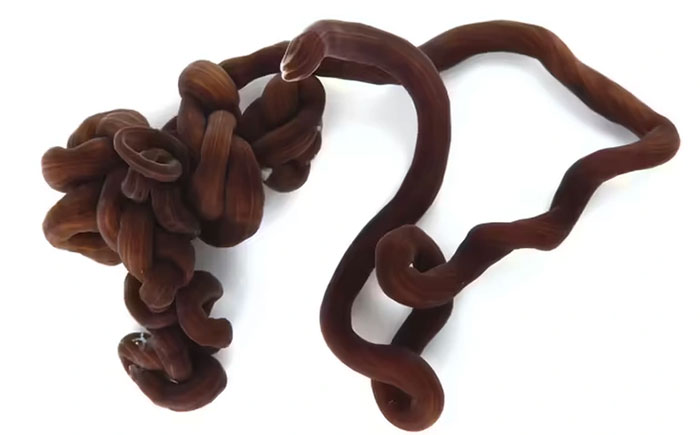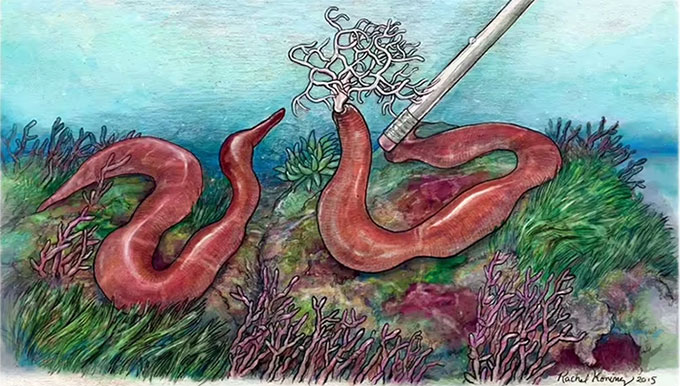Strangely small creatures, but longer than blue whales
The bootlace worm is one of the longest animals on Earth. Once, they were found on the beach with a length of up to 55 meters.
A tiny, scrawny creature, and not much wider than a pencil, the bootlace worm (Lineus longissimus) is remarkable in length. They are considered the longest living creatures today, sometimes rivaling (or possibly surpassing) blue whales.

The bootlace worm is one of the longest animals on Earth.
In a 2008 article for the journal Zoologische Mededelingen, biologists Adriaan Gittenberger and Cor Schipper explain that the bootlace worms grow to 98.4 feet (30 meters) long and "have been encountered several times".
However, the carcass of a giant bootlace worm is believed to have washed up on the Scottish coast in 1864. At that time, it was measured to be 55 meters long.
However, some scientists do not confirm the existence of the species Lineus longissimus can reach this extent. The reason is that these animals can stretch, elastic with deformed bodies, so it becomes difficult to judge their length.

The "faucet" structure of the bootlace worm is squeezed from a pocket inside the body as needed.
Lineus longissimus is the largest member of the animal family Nemertea, also known as "ribbon worms" or "tapworms". This group includes about 1,200 recorded species. Unlike the familiar earthworms, they do not have body segments. In addition, they are heartless, invertebrate, often hiding in the mud, sand, and rock crevices around the North Atlantic Ocean.
A striking feature of the Nemertea species is the structure with a tubular "mouth" known as a "proboscis". Usually, it is hidden in a dedicated pocket. However, when there is a need, the animal will push the proboscis to the outside of the body.
This hose has the function of helping them manipulate and catch food, be it crabs, snails, and carcasses floating on the seabed. The hose is also sometimes used as a digging tool.

Bootlance worms can be found under large seaside rocks or crevices, kelp beds, and natural seaside pools.
To ward off predators or when they feel threatened, these invertebrates secrete large amounts of thick, foul-smelling mucus.
Naturalists believe that the defensive mucus of bootlace worms contains many peptide toxins. However, when a research team examined these in 2018, they discovered a whole new class of toxins, and hitherto unknown to science.
Laboratory tests show that exposure to nemertide α-1 interferes with the nervous and musculoskeletal function of blue crabs (Carcinus maenas) and Dubia cockroaches (Blaptica dubia). That could cause the creature to die or become permanently paralyzed. Therefore, Nemertide α-1 can be used as a very effective insecticide.
- Blue whales rotate 360 degrees to hunt
- Blue whales were first discovered in the Red Sea
- Disaster turns blue whale into the largest creature on the planet
- 4 fictional creatures, but doubt it is 100% real
- Close up of the largest 170 ton blue whale on the planet
- Whales do not know how to avoid boats
- 10 giant animals on the ocean floor
- How is the secret of feeding a whale?
- 'Fire Dragon' on the ocean floor
- The difficult reason makes the Megalodon shark extinct
- Video: Whales familiarize people on the beach
- Video: Flock of ferocious whales eating main meat
 Surprised: Fish that live in the dark ocean still see colors
Surprised: Fish that live in the dark ocean still see colors Japan suddenly caught the creature that caused the earthquake in the legend
Japan suddenly caught the creature that caused the earthquake in the legend A series of gray whale carcasses washed ashore on California's coast
A series of gray whale carcasses washed ashore on California's coast Compare the size of shark species in the world
Compare the size of shark species in the world